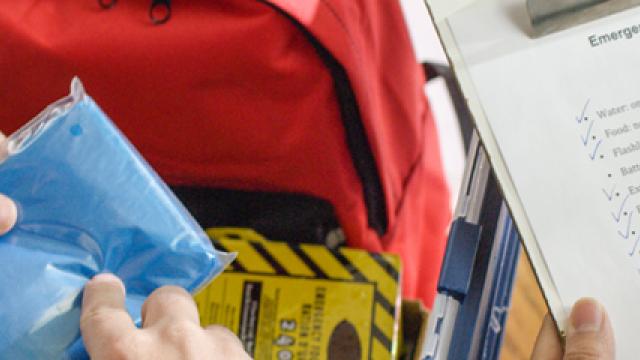Natural disasters and other emergencies can strike without warning. In the event of an emergency, there’s a good chance that public safety service personnel will be busy handling emergencies. That's why it's important to be prepared at all times.
The following tips are designed to help you prepare for and respond to an emergency.
Before an Emergency
Your Natural Gas Meter
Know where your natural gas meter is located and keep a 12-inch or larger adjustable wrench with your emergency supplies, near your building exit or next to your natural gas meter shut-off valve.
Don't store the wrench on the natural gas meter or other natural gas piping. In the event of an earthquake or other emergency, turn off your natural gas meter if you smell natural gas, hear natural gas leaking or see other signs of a leak-- and ONLY if it is safe to do so. Depending on how many customers are without natural gas service, it may take an extended period of time for SoCalGas to turn your natural gas services back on.
Secure Your Water Heater
To keep your water heater from moving or toppling in an earthquake, strap it firmly to the wall studs in two places - the upper and lower one-third of the tank - with heavy bolts and metal strapping.
Be sure to place the lower strap at least four inches above the thermostat controls. Kits are usually available at your local hardware store and we recommend having a qualified professional install it for you.
Use Approved Flexible Connectors
Call SoCalGas® or a licensed, qualified professional to replace any semi-rigid aluminum or copper natural gas tubing appliance connectors with an approved flexible connector.
Check Safety Devices
Check your safety devices, such as smoke and carbon monoxide detectors, to make sure they're functioning properly.
Call SoCalGas or a qualified professional to inspect your furnace and other natural gas appliances for safe operation. Make sure flexible connectors aren't subject to damage or passing through floors, walls or ceilings.
Develop an Emergency Preparedness Plan
Most of us have thought about what we would do in an emergency. Unfortunately, most of us never go beyond just thinking about it. Even worse, some people believe that having stored food supplies and a few thoughts about what they'd do in an emergency is being prepared.
The truth is, without formalizing your thoughts on how to approach various emergencies, you aren't prepared. Being prepared means more than just having a store of supplies available; it means having a written plan that includes training and practice. Developing a written plan not only organizes your thoughts, it provides a repeatable approach to emergencies. It's an excellent tool for training and practicing.
Your plan should be tailored to your specific situation and the specific emergency you're responding to. For example, what will you do in the event of a fire versus an earthquake or flood?
Here are a few examples of emergencies for you to consider:
- House or wild fire
- Flooding
- Earthquake
- Intruder
- School or work emergency
- Large chemical spills near your neighborhood
How to Create an Emergency Plan
When creating an emergency plan for your family, start by identifying two places for your family to meet:
- Identify two places for your family to meet:
- Somewhere outside your home.
- Somewhere away from your neighborhood in case you can't return home.
- Make sure your children are aware of the routes to both locations.
- Plan safe routes away from your home and business to high, safe ground.
- Develop a plan for family pets and livestock. Evacuation shelters may not allow animals.
- Practice the plan with your family, including your children.
- Review the emergency plans at your workplace, your children's school or daycare center and other places where members of your family regularly spend time away from home.
- Keep current important documents in a safe-deposit box.
- Know if your home is in an area at risk of flooding or landslide.
- Clean debris from drains around your home or yard.
- Review and update your plan, as needed -- at least yearly.
Emergency Supplies Checklist
Now is the time to stock up on at least 72 hours worth of emergency supplies for your safety and comfort during and after an earthquake or other emergency.
Below are some essential items to include in your emergency preparedness kit:
- Bottled water -- three-day supply of bottled water (one gallon per person, per day)
- First-aid kit, handbook and essential medications
- Packaged, dried or canned food and any special diet items
- Special provisions for babies, elderly, disabled family members and pets
- Non-electric can opener
- Blankets or sleeping bags
- A portable radio, flashlight, batteries and light sticks
- Extra eyeglasses and sets of house and car keys
- Fire extinguisher — A-B-C type
- Rubber boots, rain poncho
- Plastic trash bags
- Sturdy pair of shoes, warm clothing and personal hygiene items
- Cash
After an Emergency
Your Natural Gas Meter
- DON'T turn off your natural gas meter unless you smell natural gas, hear the sound of natural gas escaping or see other signs of a leak--and ONLY if it is safe to do so. Depending on how many customers are without natural gas service, it may take an extended period of time for SoCalGas to turn your natural gas services back on.
- If you turn off natural gas to the meter, leave it off. Don't turn it back on yourself. Interior natural gas piping and appliances must be inspected for damage before service can be safely restored.
- Call us to turn the natural gas back on, to relight the pilots and service your appliances. Note that certain repairs may have to be performed by your plumber or heating contractor. However, only our field employees are allowed to turn on the natural gas to your meter.
Use Your Shut-off Valves
For safety, a shut-off valve should be installed at every natural gas appliance, and may be required by state and/or local codes. If a leak occurs at a specific appliance, the valve allows you to turn off the natural gas at the appliance rather than shut off all of your natural gas service. Some valves require a wrench to turn them.
Check the Venting System
Check your water heater and furnace vents. If the venting system becomes separated during an earthquake or other event, it could leak hazardous fumes into your home. Do not operate your appliance unless it is properly vented. Signs of an improperly vented appliance may include moisture on the inside of windows or an unusual odor when the appliance is in operation.
Natural Gas Safety
- DON'T smoke, ignite a flame or use any electrical appliances, light switches or other devices that can cause a spark until you're sure there are no natural gas leaks.
- Use spark-free flashlights -- NOT lanterns, matches, lighters or candles -- to examine buildings, as flammable gases may be inside.
Evacuation
If evacuation is necessary, prepare an evacuation kit, including personal hygiene items, change of clothes, bedding and medication, if possible. Food, shelter and first aid are available at shelters.
More Emergency Tips
- If safe to do so, check on your neighbors, especially elderly, disabled or other persons with special needs.
- Use the telephone only for family emergencies, or to report unsafe or dangerous conditions.
- Don't use 911 unless you have a life-threatening emergency.
- Avoid unnecessary trips. If you have to travel during an emergency, dress in warm, loose layers of clothing and sturdy shoes. Let others know where you're going.
- Keep informed of the situation through local radio and television.
- Follow the instructions of local authorities regarding the safety of drinking water. If in doubt, boil or purify water before drinking, or call public health officials. Avoid "sightseeing" in disaster areas. You may hamper rescue efforts or place yourself in danger.
Earthquake Preparedness
Do a Home "Hazard Hunt"
Walk through your rooms and look for things that could fall when shaken. Identify good places to "duck, cover and hold." Even though you may not be able to secure every item you believe could fall, at least you will have identified the safe and unsafe areas of your home.
Practice Your "Duck, Cover and Hold"
Duck or drop to the floor, take cover under a sturdy desk or table, and hold onto it. If you have children, teach them how to "duck, cover and hold," and be sure to practice it with them often.
During an Earthquake
Duck or drop to the floor, take cover under a sturdy desk or table, and hold onto it so that it doesn't move away from you. Wait there until the shaking stops.
Find Out About:

